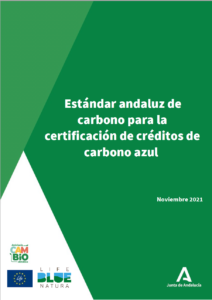Within the carbon withdrawn by the biosphere, a distinction can be made between that captured in terrestrial ecosystems (green carbon) and that captured in marine ecosystems (blue carbon). Although it ultimately implies a net removal of CO2 from the atmosphere in both cases, there are important differences between them. In terrestrial ecosystems, the main carbon reservoir (compartment where carbon accumulates in the long term) is the biomass of woody plants and, secondly, the soil. In contrast, in marine ecosystems, sediment is the main carbon reservoir. This is mainly due to: 1) the non-existence of fires in the marine environment, which prevents the oxidation of this carbon and its return to the atmosphere in the form of CO2; 2) the lower oxygen levels of marine sediments, which promotes anoxic conditions and thus reducing the oxidation of the buried carbon; and 3) the existence of a continuous sedimentation that buries and sequesters the deposited carbon. For all these reasons, the rates of carbon accumulation in the soil are up to 15 times higher in the marine ecosystems, assuming globally more than 55% of the total carbon buried annually in the biosphere.
Despite the importance that blue carbon may have in reducing the concentration of CO2 in the atmosphere, and therefore helping to mitigate the effects of climate change, its acknowledgment (in 2009 after the publication of the Blue Carbon Report) and inclusion in international political agendas after the COP21 in Paris has been much more recent, unlike green carbon (since 1997 in the Kyoto Protocol). In the latter case, there have been international agreements for more than 10 years (for example, REDD+) or specific national legislation that allows carbon offsetting and the implementation of carbon absorption projects (for example, the registration of carbon footprints, carbon offsetting and CO2 absorption projects from the Spanish MITECO).

However, there is still no legislation for blue carbon at the European or national level that allows the registration and certification of blue carbon projects (and the corresponding carbon removals); yet, there are some international standards from private entities (for example Gold Standard or VERRA).
The Autonomous Community of Andalusia is pioneer at the Spanish and European levels after the recent publication (November 2021) of the “
Andalusian Carbon Standard for the certification of blue carbon credits“, which allows to have a standard for the approval and certification of atmospheric carbon removals from projects developed in blue carbon ecosystems; that is, in seagrasses and tidal saltmarshes. This standard, integrated into the Andalusian Emissions Compensation System (SACE), launches the possibility for companies to voluntarily offset their CO
2 emissions through the execution of reforestation and conservation projects in blue carbon ecosystems, thus providing the companies with the opportunity to participate actively in climate change mitigation. The Andalusian Standard for the certification of blue carbon credits has an operating structure similar to that of the absorption projects of the
MITECO Carbon Footprint Registry, which would allow their rapid integration in the future. This seems to be possible after the recent
modification of Royal Decree 163/2014 (in the consultation phase), which creates the carbon footprint register, compensation and carbon dioxide absorption projects, and which includes for the first time, similar to the Andalusian regulations, the term blue carbon.

